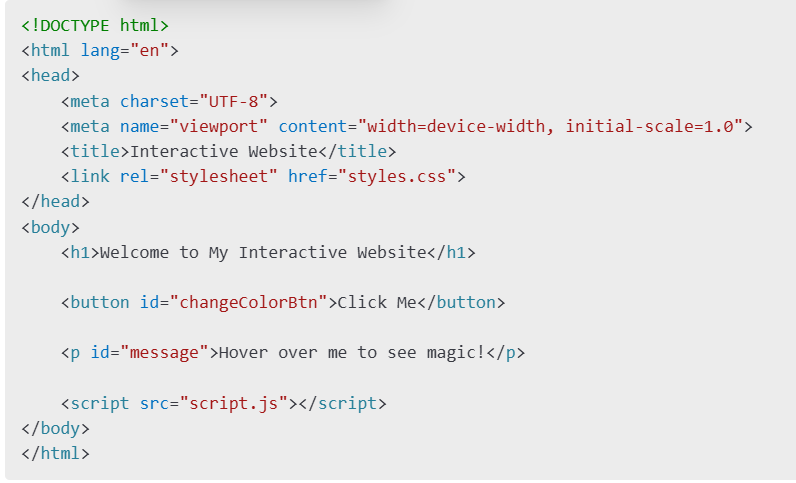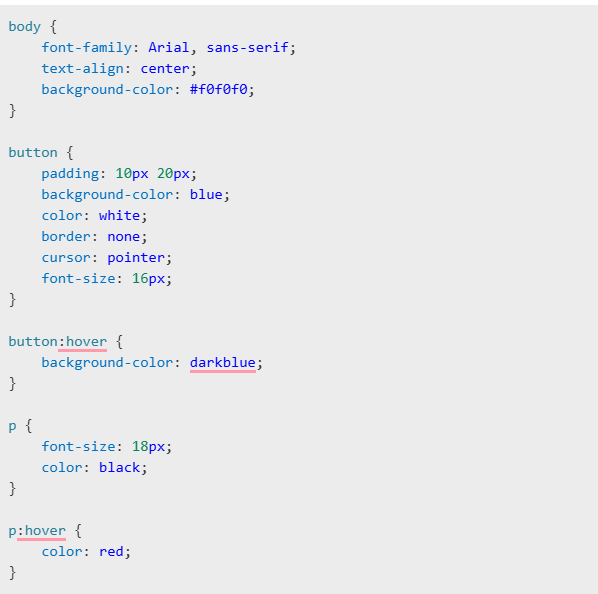Creating an interactive website is an exciting way to engage users and improve the user experience.
Using HTML, CSS, and JavaScript, you can add interactive elements like buttons, animations, and dynamic content.
Interactivity makes a website more engaging and user-friendly, allowing visitors to interact with elements, change content dynamically, and enjoy a seamless browsing experience.
Whether you’re building a personal blog, an e-commerce site, or a portfolio, adding interactive features can enhance usability and keep visitors engaged.
This guide walks through the steps to build a basic interactive website, covering the essentials of structure, styling, and scripting.
Step-by-Step Guide to Making an Interactive Website Using HTML
Creating an interactive website requires HTML for structure, CSS for styling, and JavaScript for interactivity. Here are the steps to make a website using HTML.
Adding dynamic elements like forms, animations, and navigation menus improves user experience. Implementing responsive design ensures the website adapts to different screen sizes for better accessibility.
Understanding the Basics
Before diving into coding, let’s understand the roles of each technology. HTML organizes the content, CSS enhances the design, and JavaScript introduces interactive features.
HTML (HyperText Markup Language)
HTML is the foundation of any website. It structures content using elements such as headings, paragraphs, images, and links.
Each element is wrapped in tags that define its role. For example, <h1> is used for headings, and <p> is used for paragraphs.
HTML also includes forms, tables, and lists, allowing users to interact with content effectively.
Without HTML, a website cannot exist, as it provides the essential framework upon which styling and interactivity are applied.
CSS (Cascading Style Sheets)
CSS enhances the visual appearance of a website by defining styles for fonts, colors, spacing, and layout.
It enables developers to build adaptable designs that fit various screen sizes. CSS properties like display, flexbox, and grid help structure content effectively.
With CSS animations and transitions, web pages become more engaging. Using external stylesheets, developers can maintain consistency across multiple pages while keeping the HTML structure clean and organized.
JavaScript
JavaScript brings life to a website by adding interactivity and dynamic behavior. It enables user interactions such as clicking buttons, filling out forms, and loading new content without refreshing the page.
JavaScript frameworks and libraries, like React or jQuery, further simplify the process of building interactive components.
With JavaScript, websites can handle real-time data, create interactive elements, and enhance user engagement through animations, sliders, and event-driven programming.
Setting Up the Project
When creating a simple web project, you need three main files:
- index.html – This is the core file that structures your webpage. It contains headings, paragraphs, images, buttons, and links that appear on the page. Every website starts with this file, as it defines the content users see.
- styles.css – This file is responsible for the appearance of your webpage. It controls colors, fonts, spacing, backgrounds, and the overall design. Without this file, the webpage would look plain and unstyled.
- script.js – This is the JavaScript file that adds interactivity to your website. It allows buttons to function, forms to be submitted, and animations to run. This makes the webpage dynamic instead of static.
Steps to Set Up the Project
- Create a Folder – First, make a new folder on your computer where you will store all the files for this project.
- Create the HTML File – Inside the folder, create a file named index.html. This file is the backbone of your webpage and contains all the text and elements users will see.
- Create the CSS File – Next, create a file named styles.css. This file is used to style your webpage, making it look visually appealing by changing colors, fonts, layouts, and more.
- Create the JavaScript File – Finally, create a file named script.js. This file will make your webpage interactive by adding effects like button clicks, pop-ups, and animations.
How These Files Work Together?
- index.html holds the webpage’s content, such as text, images, and buttons.
- styles.css applies styles to make the page look attractive.
- script.js adds interactive features, such as alerts and animations.
Viewing Your Project
After setting up these three files, open the index.html file in a web browser. This will display your webpage, showing how the HTML, CSS, and JavaScript files work together. If changes are made in the CSS or JavaScript files, refreshing the browser will update the page with new styles or features.
This setup is the foundation for building websites, and these three files are essential in any web development project.
Writing the HTML Structure
The HTML structure is the foundation of any webpage. It organizes content using elements like headings, paragraphs, images, and links.
Every HTML file starts with a DOCTYPE declaration, followed by the <html> tag that contains the <head> and <body> sections.
The head includes metadata, the title, and links to external stylesheets. The body holds visible content such as text, buttons, and images.
Proper structuring ensures readability, accessibility, and search engine optimization (SEO).
Using semantic tags like <header>, <section>, and <footer> improves organization and clarity.
A well-structured HTML document is essential for an efficient and user-friendly website.

Adding Styles with CSS
CSS (Cascading Style Sheets) is utilized to design and improve the visual presentation of a webpage.
It controls colors, fonts, spacing, backgrounds, and layouts.
By linking a CSS file to an HTML document, you can change the design without modifying the HTML structure.
CSS allows customization of text styles, button designs, and page responsiveness. It supports different styling methods, including external, internal, and inline CSS.
Using CSS frameworks like Bootstrap can simplify styling. A well-designed CSS file improves user experience, making a website visually appealing, professional, and easy to navigate across different devices and screen sizes.

Adding Interactivity with JavaScript
JavaScript makes websites dynamic and interactive by allowing users to engage with elements like buttons, forms, and animations.
It enables real-time updates, pop-up messages, and form validations without reloading the page.
JavaScript interacts with HTML and CSS, making it possible to modify content, change styles, and respond to user actions.
Common features include dropdown menus, image sliders, and interactive maps. JavaScript frameworks like React and Vue simplify development for complex applications.
Adding JavaScript, websites become more engaging, responsive, and user-friendly, enhancing the overall browsing experience and improving functionality across different devices.

Running Your Website
To view your website, follow these simple steps:
- Save All Files in the Same Folder – Ensure that your index.html, styles.css, and script.js files are in the same project folder. This keeps everything organized and allows the files to work together correctly.
- Open index.html in a Web Browser – Locate the index.html file, then double-click it. It will automatically open in your default web browser, displaying the structured webpage with applied styles and interactive features.
- Make Changes and Refresh – If you edit your HTML, CSS, or JavaScript files, save the changes and refresh the browser to see updates.
- Use a Local Server (Optional) – For more advanced projects, you can use a local server like XAMPP, WAMP, or Python’s built-in server to run your website smoothly, especially when working with dynamic features.
- Test on Different Browsers – Open your website in different browsers like Chrome, Firefox, or Edge to ensure compatibility and consistent display.
- Upload to the Internet – To share your website, you can upload it to hosting platforms like GitHub Pages, Netlify, or a personal web server.
Expanding the Interactivity
Making your website interactive improves user engagement and provides a better experience. JavaScript plays a key role in adding dynamic features that make your site more functional.
For example, you can create real-time updates, interactive maps, and custom alerts that respond to user actions.
Interactive menus and dropdowns help users navigate easily, making the website more user-friendly. Adding real-time search functionality allows users to find information quickly.
Hover effects and tooltips can provide additional details without cluttering the page.
Another way to enhance interactivity is by integrating live chat or chatbot features, which improve customer support. Auto-updating content, such as real-time notifications or stock price updates, can also improve usability.
Using JavaScript libraries like jQuery or frameworks like React can make coding easier while ensuring smooth performance.
Interactive websites keep visitors engaged, encouraging them to spend more time exploring your content and services.
- A dark mode toggle
- An image slider
- A form with validation
- Smooth animations
Here’s an example of a dark mode toggle feature

How BrandOut Can Help You Build a Website?
BrandOut simplifies website creation by offering professional design, web development services.
They create user-friendly, responsive, and SEO-optimized websites tailored to your needs. From interactive features to secure hosting, BrandOut ensures a seamless experience.
With expert support and scalable solutions, they help businesses and individuals build a strong online presence effortlessly.
Conclusion:
Creating an interactive website is simple with HTML, CSS, and JavaScript. This guide covered the basics of adding dynamic elements.
You can enhance your site by experimenting with animations, forms, and JavaScript libraries like jQuery or React.
Adding interactive features improves user experience and engagement. Keep exploring new techniques to make your website more functional and visually appealing.
Most Asked Questions:
How to Create an Interactive HTML?
To create an interactive HTML page, you need to use JavaScript along with HTML and CSS.
JavaScript allows users to interact with elements, such as clicking buttons, hovering over images, or submitting forms.
You can add interactive features like drop-down menus, modals, and animations using JavaScript or frameworks like React and jQuery.
CSS also helps by adding hover effects, transitions, and animations.
How to Make an Interactive Form in HTML?
To create an interactive form, use HTML for structure and JavaScript for validation. Add input fields, dropdowns, and buttons in the form.
Use JavaScript to validate user input (e.g., checking if an email is correctly formatted). You can also display real-time feedback, such as error messages or success confirmations.
How Can I Create an Interactive Website?
An interactive website includes dynamic elements like animations, forms, buttons, and real-time updates.
Use JavaScript for event handling, CSS for styling, and frameworks like React or Vue for advanced interactivity. Features like chatbots, notifications, and interactive images make the site engaging.
How Do I Create an Interactive Link in HTML?
To create an interactive link, use the <a> tag with JavaScript or CSS effects. Adding target=”_blank” opens links in a new tab. You can also use JavaScript to make links trigger pop-ups, tooltips, or animations when clicked.
CSS hover effects can change the link’s color, size, or underline style for better user experience.





